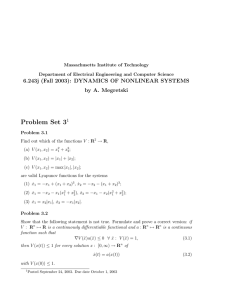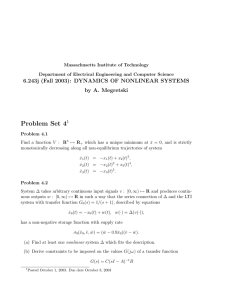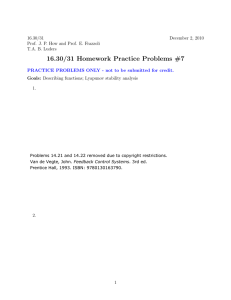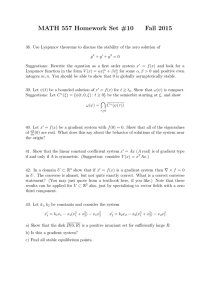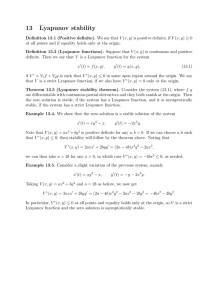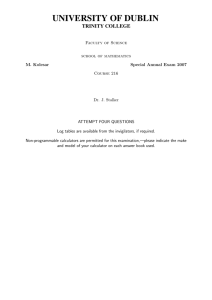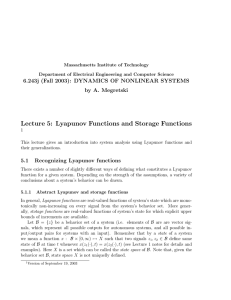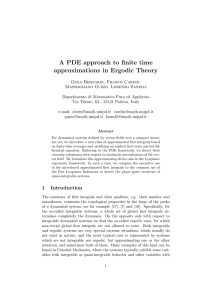Massachusetts Institute of Technology
advertisement
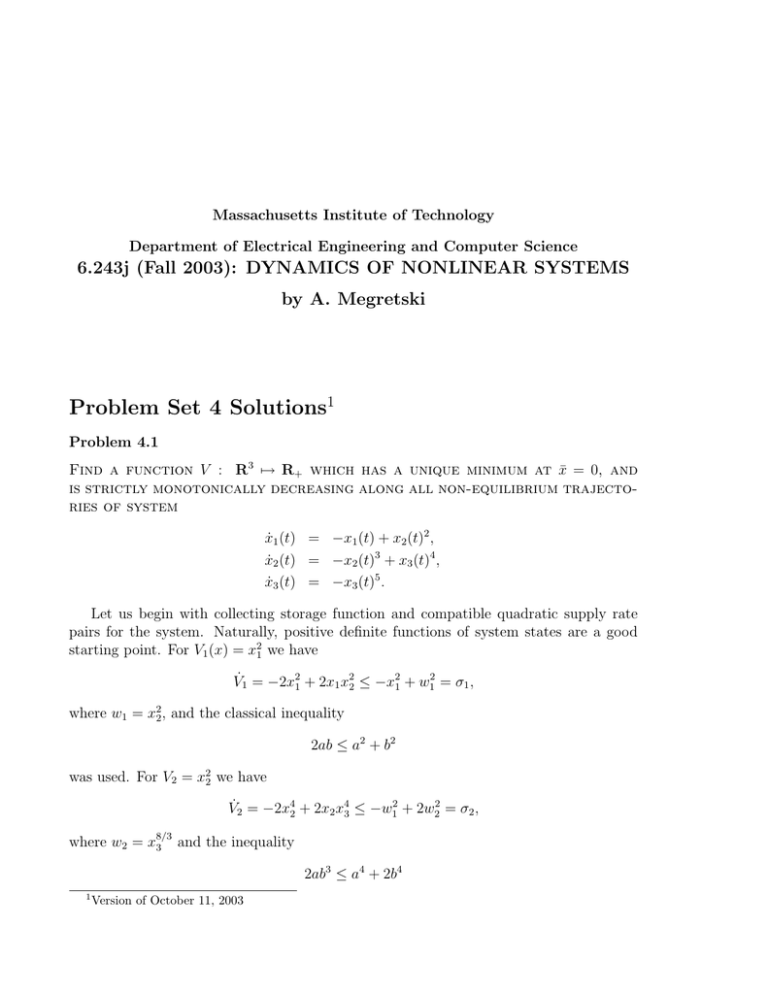
Massachusetts Institute of Technology
Department of Electrical Engineering and Computer Science
6.243j (Fall 2003): DYNAMICS OF NONLINEAR SYSTEMS
by A. Megretski
Problem Set 4 Solutions1
Problem 4.1
Find a function V : R3 ≥� R+ which has a unique minimum at x¯ = 0, and
is strictly monotonically decreasing along all non-equilibrium trajecto­
ries of system
ẋ1 (t) = −x1 (t) + x2 (t)2 ,
ẋ2 (t) = −x2 (t)3 + x3 (t)4 ,
ẋ3 (t) = −x3 (t)5 .
Let us begin with collecting storage function and compatible quadratic supply rate
pairs for the system. Naturally, positive definite functions of system states are a good
starting point. For V1 (x) = x21 we have
V̇1 = −2x21 + 2x1 x22 � −x12 + w12 = �1 ,
where w1 = x22 , and the classical inequality
2ab � a2 + b2
was used. For V2 = x22 we have
V̇2 = −2x42 + 2x2 x34 � −w12 + 2w22 = �2 ,
8/3
where w2 = x3
and the inequality
2ab3 � a4 + 2b4
1
Version of October 11, 2003
2
4/3
(a weakened version of a classical inequality) was used. Finally, for V3 = 3x3
16/3
V̇3 = −4x3
we have
= −4w22 .
Now, for
V = c 1 V1 + c 2 V2 + c 3 V3
we have
V̇ � c1 �1 + c2 �2 + c3 �3 = −c1 x21 + (c1 − c2 )w12 + (2c2 − 4c3 )w22 .
Taking c1 = 1, c2 = c3 = 2 yields a continuously differentiable Lyapunov function
4/3
V (x) = x21 + 2x22 + 6x3
for which the derivatives along system trajectories are bounded by
16/3
V̇ (x) � −x21 − x42 − 4x3
.
Problem 4.2
System � takes arbitrary continuous input signals v : [0, →) ≥� R and
produces continuous outputs w : [0, →) ≥� R in such a way that the series
connection of � and the LTI system with transfer function G 0 (s) = 1/(s +
1), described by equations
ẋ0 (t) = −x0 (t) + w(t), w(·) = �(v(·)),
has a non-negative storage function with supply rate
�0 (¯
x0 , v,
¯ w)
¯ = (w¯ − 0.9¯
x0 )(¯
v − w).
¯
(a) Find at least one nonlinear system � which fits the description.
The ideal saturation nonlinearity
sat(y) =
�
y/|y|, |y| ∀ 1,
y,
|y| � 1,
is a nice example of � satisfying the conditions. Indeed, if
ẋ0 (t) = −x0 (t) + sat(v(t)), x0 (0) = 0
then |x0 (t)| � 1 for all t ∀ 0. Hence
(v(t) − sat(v(t)))(sat(v(t)) − x0 (t)) ∀ 0 � t ∀ 0
(if v(t) ≤ [−1, 1] then the product equals zero, otherwise the multipliers have same
sign).
3
(b) Derive constraints to be imposed on the values G(j�) of a transfer
function
G(s) = C(sI − A)−1 B
with a Hurwitz matrix A, which guarantee that x(t) � 0 as t � → for
every solution of
ẋ(t) = Ax(t) + Bw(t), v(t) = Cx(t), w(·) = �(v(·)).
Make sure that your conditions are satisfied at least for one non­
zero transfer function G = G(s).
Let us prove that condition
�
0.1 − j�
>0 ��≤R
Re (1 − G(j�))
1 − j�
(4.1)
is sufficient to guarantee that x(t) � 0 as t � →. Indeed, since A is a Hurwitz
matrix, and G is strictly proper, there exists π > 0 such that
�
0.1 − j�
Re (1 − G(j�))
> π(1 + |(j�I − A)−1 B|2 ) � � ≤ R.
1 − j�
Therefore, the frequency inequality conditions of the KYP Lemma are satisfied for
the existence of a matrix P = P � such that
�
� �
x
Ax + Bw
2
P
� (w−Cx)(w−0.9x0 )−π(|x|2 +|w|2 ) � w, x0 ≤ R, x ≤ Rn .
x0
w − x0
To show that P is positive definite, substitute w = x0 into the last inequality, which
yields
�
� �
x
Ax + Bx0
2
� −π(|x|2 + |0.9x0 |2 ) � x0 ≤ R, x ≤ Rn ,
P
x0
−0.1x0
which is equivalent to the Lyapunov inequality
P  + Â� P = −Q,
where
 =
�
A B
0 −0.1
, Q=π
�
I
0
0 0.81
.
Since  is a Hurwitz matrix, and Q = Q� > 0, it follows that P > 0.
Now
V = V0 +
�
x
x0
�
P
�
x
x0
4
is a non-negative storage function for the closed loop system, with supply rate
� = −π(|x|2 + |w|2 ).
Hence w is square integrable over the interval [0, →). Since
ẋ = Ax + Bw,
and A is a Hurwitz matrix, this implies that x(t) � 0 as t � →.
Since
Re
0.1 − j�
∀ 0.1 � � ≤ R,
1 − j�
condition (4.1) is satisfied for all G with sufficiently small H-Infinity norm (maximal
absolute value of the frequency response).
Problem 4.3
For the pendulum equation
ÿ(t) + ẏ + sin(y) = 0,
find a single continuously differentiable Lyapunov function V = V (y, ẏ)
that yields the maximal region of attraction of the equilibrium y = ẏ = 0.
(In other words, the level set
{¯
x ≤ R2 : V (¯
x) < 1}
schould be a union of disjoint open sets, one of which is the attractor �
of the zero equilibrium, and V (y(t), ẏ(t)) schould have negative derivative
at all points of � except the origin.)
Note that the problem can be interpreted as follows: given the initial angular position
and angular velocity of a pendulum, find the number of complete rotations it will have
before settling at an equilibrium position. An “exact analytical” answer can be obtained
by stating that the maximal region of attraction is the area bounded by the four separa­
trix solutions of the system equation, converging to the two unstable equilibria (0, ±�).
However, this “exact” answer (which cannot be expressed in elementary functions) will
be of no use in the case when the pendulum model is slightly modified (a different friction
model, flexibility of the pendulum taken into account, etc.) On the other hand, one can
expect that an estimate obtained by using a Lyapunov function will be more “robust”
with respect to various perturbations of the model.
An obvious Lyapunov function is given by the system energy (potential plus kinetic)
V0 (y, ẏ) = 0.5ẏ 2 − cos(y), dV /dt = −ẏ(t)2 .
5
To estimate the region of attraction of the equilibrium at the origin, using this Lyapunov
function, one may can find a constant c such that the level set
L(V0 , c) = {(y0 , y1 ) : V0 (y0 , y1 ) < c}
does not contain a path connecting the origin with any other equilibrium of the system.
It is easy to see that taking c = 1 does the job, and yields the region of attraction � 0
given by
�0 = {(y, ẏ) : 0.5ẏ 2 − cos(y) < 1, −� < y < �}.
This appears to be a very poor estimate, taking into account what we know about the
true maximal region of attraction.
To get a better Lyapunov function, one can try to construct it in such a way that the
level sets are polytopes centered at the origin. Remember that a function V is a Lyapunov
function if and only if the system trajectories never leave any of its level sets. Since the
boundary of a polytope in R2 is a segment, it is especially easy to check this condition
for the Lyapunov functions candidates with polytopic level sets.
One of the simplest examples of a Lyapunov function constructed this way is given by
�
|y| + |ẏ|,
yẏ ∀ 0,
V1 (y, ẏ) =
max{y, ẏ}, yẏ � 0.
It is easy to check that V1 is a Lyapunov function for the pendulum system in the area
�1 = {(y, ẏ) : V1 (y, ẏ) < �},
which is also the resulting estimate of the region of attraction.
The previous estimate �0 is contained in �1 . Even better estimates can be obtained
by using other lyapunov functions with polytopic level sets.
